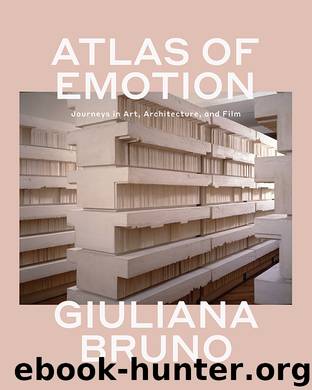Atlas of Emotion by Bruno Giuliana.;

Author:Bruno, Giuliana.;
Language: eng
Format: epub
Publisher: Lightning Source Inc. (Tier 1)
SITUATIONIST PSYCHOGEOGRAPHY
With the aid of old maps … one can draw up hitherto lacking maps of … changing architecture and urbanism.
Guy Debord
The voyage of emotion traced by way of Madeleine de Scudéry’s Carte de Tendre, which has moved us through various representational histories, inspired an art of mapping that eventually came to inhabit the very fabric of the conjoined urban and filmic screen of emotions. Locating the emotion in this psychogeography, we turn to the map of the lived city designed by the situationists in order to propose the geopolitical substance of “transport” across mapping and film. As mentioned, both tender mapping and cinema played important roles in the situationists’ mapping of psychogeography. The group reprinted the Carte de Tendre in the Internationale situationniste.60 It also reinvented it in two maps, one of which is named after a film. Both of these maps, attributed to Guy Debord and Asger Jorn, were modeled after Scudéry’s chart and, in tracing the drift of a city dweller’s own psychospatial negotiation, redraft its investment in intersubjective social space.
The recent critical focus on situationism, as exemplified in the work of Thomas McDonough, reveals that a most crucial legacy of this movement lies in its conception of space, previously underplayed in the critique of visual spectacle, even though space was central to the group’s project.61 This critical revision of situationism includes specific attention to the movement’s articulate views on architecture and “unitary urbanism,” enlightening their practice of atmosphere and ambiance and their geopolitics of the city, built on a new architecture of social space with nomadic forms of transformation.62 My own contribution to this discourse lies in approaching the issue of a mobile architecture of living; here, I take the group’s construction of situations, in terms of lived ambiances and lived experiences, as a place of research on the relationship between spaces and emotions. Exploring geopsychic space from the perspective of film criticism, I focus on their cartographic thinking, tracing the way in which situationist mapping converges with the area of my specific cartographic concern: the intersection of filmic space and Scudéry’s map.63 To foreground the tender extension of psychogeography, my observations focus on the interplay between the film The Naked City (Jules Dassin, 1948) and the situationist map that bears its name.
The Naked City map is an assemblage of fragments, whose montage playfully remakes an urban topography into a social and affective landscape. It was constructed from nineteen segments of a map of Paris that, having undergone a process of détournement in a creative intervention that forms new relations among the city’s parts and their inhabitant-passengers, is then reconfigured with red directional arrows that link the cutouts. These arrows are referred to as plaques tournantes because they function as “turntables” (like those used to rotate trains) that describe the subject’s reorientation as he or she passes through various psychogeographic realms and “unities of atmosphere.” An actual “locomotive” reinstatement of what was, in effect, a “wheel,” the plaques tournantes mark the dweller’s way of living the city in its intensity as a psychogeographic recreation of new (e)motions.
Download
This site does not store any files on its server. We only index and link to content provided by other sites. Please contact the content providers to delete copyright contents if any and email us, we'll remove relevant links or contents immediately.
The Kite Runner by Khaled Hosseini(4506)
Gerald's Game by Stephen King(3943)
The Perils of Being Moderately Famous by Soha Ali Khan(3795)
Dialogue by Robert McKee(3608)
Story: Substance, Structure, Style and the Principles of Screenwriting by Robert McKee(3005)
The 101 Dalmatians by Dodie Smith(2953)
The Pixar Touch by David A. Price(2753)
Confessions of a Video Vixen by Karrine Steffans(2691)
Fantastic Beasts: The Crimes of Grindelwald by J. K. Rowling(2558)
How Music Works by David Byrne(2556)
Slugfest by Reed Tucker(2434)
Harry Potter 4 - Harry Potter and The Goblet of Fire by J.K.Rowling(2429)
The Mental Game of Writing: How to Overcome Obstacles, Stay Creative and Productive, and Free Your Mind for Success by James Scott Bell(2403)
Wildflower by Drew Barrymore(2127)
Scandals of Classic Hollywood: Sex, Deviance, and Drama from the Golden Age of American Cinema by Anne Helen Petersen(2119)
Casting Might-Have-Beens: A Film by Film Directory of Actors Considered for Roles Given to Others by Mell Eila(2080)
Screenplay: The Foundations of Screenwriting by Syd Field(2076)
Robin by Dave Itzkoff(2017)
The Complete H. P. Lovecraft Reader by H.P. Lovecraft(1986)
